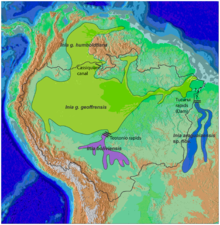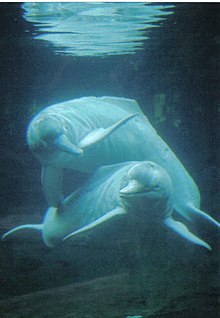Amazon river dolphin
| Amazon river dolphin | |
|---|---|

| |
| Size comparison against an average human | |
| Scientific classification | |
| Kingdom: | |
| Phylum: | |
| Class: | |
| Subclass: | |
| Order: | |
| Suborder: | |
| Superfamily: | |
| Family: | Gray, 1846
|
| Genus: | |
| Species: | I. geoffrensis
|
| Binomial name | |
| Inia geoffrensis Blainville, 1817
| |

| |
| Amazon river dolphin range | |
The Amazon river dolphin, alternately Bufeo, Bufeo Colorado, Boto, Boto Cor de Rosa, Boutu, Nay, Tonina, or Pink River Dolphin[2] (Inia geoffrensis), is a freshwater river dolphin endemic to the Orinoco, Amazon and Araguaia/Tocantins River systems of Brazil, Bolivia, Peru, Ecuador, Colombia and Venezuela. The largest of the river dolphins, this species is not to be confused with the Tucuxi (Sotalia fluviatilis), whose range overlaps that of the Amazon river dolphin but is not a true river dolphin. Because they are unfused, the neck vertebrae of the Amazon river dolphin are able to turn 180 degrees. The pink dolphin lives in the freshwater of the Amazon River. This species looks like the grey dolphin, but individuals are bigger, and, instead of a dorsal fin, they have a hump on their back. Their tails are also bigger. The pink dolphin has been listed as endangered by the International Union for Conservation of the Nature due to pollution, overfishing, excessive boat trafficking and habitat loss. The brain of the river dolphin is 40% larger than a human brain.
The IUCN lists various other names to describe this species, including Amazon Dolphin, Boto Vermelho, Boto Cor-de-Rosa, Bouto, Inia, Pink Dolphin, Wee Quacker, Pink Freshwater Dolphin, Pink Porpoise, Tonina and Encantado.
Taxonomy
The species was described by Henri Marie Ducrotay de Blainville in 1817.
Rice's 1998 classification[3] lists a single species, Inia geoffrensis, in the genus Inia, with three recognized subspecies. Some older classifications, as well as some recent publications,[4] listed the boliviensis population as a separate species; however, a great majority of the scientific community, including the IUCN,[1] consider the boliviensis population to be a subspecies of Inia geoffrensis.
The three currently recognized subspecies are:
- I. g. geoffrensis - Amazon and Araguaia/Tocantins basin population (excluding Madeira River drainage area, upstream of the Teotonio Rapids in Rondonia)
- I. g. boliviensis - Amazon basin (Bolivian sub-basin) population in the Madeira drainage area in Bolivia upstream of the Teotonio Rapids
- I. g. humboldtiana - Orinoco basin population
Legend
In traditional Amazon River folklore, at night, an Amazon river dolphin becomes a handsome young man who seduces girls,[5] impregnates them, and then returns to the river in the morning to become an Amazon river dolphin again. This dolphin shapeshifter is called an encantado. It has been suggested that the myth arose partly because dolphin genitalia bear a resemblance to those of humans.[6] Others believe that the myth served (and still serves) as a way of hiding the incestuous relations which are quite common in some small isolated communities alongside the river.[citation needed] In the area, there are tales that it is bad luck to kill an Amazon river dolphin. Legend also states that if a person makes eye contact with an Amazon river dolphin, that person will have nightmares for the rest of his/her life. Local legends also state that the dolphin is the guardian of the Amazonian manatee, and that, should one wish to find an Amazonian manatee, one must first make peace with the Amazon river dolphin.
Associated with these legends is a culture of use of various fetishes such as dried eyeballs and genitalia.[6] The use of these fetishes may or may not be accompanied by the intervention of a priest. Although sold as boto objects, a recent study has shown that, despite the claim of the seller and the belief of the buyers, none of these fetishes are derived from the boto. They are derived from Sotalia guianensis, are most likely harvested along the coast and the Amazon River delta, and then are traded up the Amazon River. In inland cities that are far from the coast, many if not most of the fetishes are derived from domestic animals such as sheep and pigs.[7]

The 1987 Brazilian film Ele, o Boto is a supernatural romance featuring an Amazon river dolphin who has a son by a young woman.
Food and diet
The Amazon river dolphin has about 100 peg-like front teeth for catching prey, and it mainly eats crustaceans, small turtles, catfish, piranhas, and other fish.
Size
Female Amazon river dolphins are 8.25 to 9.75 feet long (2.5 to 3 meters) and weigh as much as a full-grown human man, about 200 pounds. Males are normally larger than females.
References
- ^ a b Template:IUCN2008 Database entry includes a lengthy justification of why this species is data-deficient.
- ^ "Wildfacts: Boto". BBC. Retrieved 2007-02-21.
- ^ Rice, D. W. (1998). Marine mammals of the world: systematics and distribution. Society of Marine Mammalogy Special Publication Number 4. p. 231.
- ^ Martínez-Agüero, M., S. Flores-Ramírez, and M. Ruiz-García (2006). "First report of major histocompatibility complex class II loci from the Amazon pink river dolphin (genus Inia)" (PDF). Genetics and Molecular Research. 5 (3): 421–431. PMID 17117356.
{{cite journal}}: CS1 maint: multiple names: authors list (link) - ^ "Whales and Dolphins" at ancientspiral.com
- ^ a b Cravalho, M. A. (1999). "Shameless creatures: An ethnozoology of the Amazon River dolphin". Ethnology. 38 (1): 47–58. doi:10.2307/3774086.
- ^ Gravena, W., T. Hrbek, V.M.F. da Silva, and I.P. Farias (2008). "Amazon River dolphin love fetishes: From folklore to molecular forensics". Marine Mammal Science. 24: 969–978. doi:10.1111/j.1748-7692.2008.00237.x.
{{cite journal}}: CS1 maint: multiple names: authors list (link)
External links
- Associação Amigos do Peixe-boi - A non-profit organization based in Manaus, Brazil, focusing on all aspects of conservation of Amazonian aquatic mammals including the Amazon river dolphin (Inia geoffrensis).
- Omacha Foundation - A non-government and non-profit organization created to study, research and protect river dolphins and other fauna and aquatic ecosystems in Colombia. Winner of the 2007 Whitley Awards (UK).
- Projeto Boto - A non-profit research project that is increasing knowledge, understanding and the conservation prospects of the Amazon's two endemic dolphins – the Amazon river dolphin (Inia geoffrensis) and the tucuxi (Sotalia fluviatilis).
- River Dolphin Research Program - Amazon innovative research project totally devoted to the study of the ecology and conservation of river dolphins in the Amazon basin, based in the Federal University of Western Pará (UFOPA). The scope of this research project focuses on ecological studies, as well as the impact that human activities have on their survival.
- Convention on Migratory Species page on the Amazon Dolphin
- The Nature Conservancy works to protect habitat for the Amazon River Dolphin
- Animal Info page on the Amazon River Dolphin
- Virtual Explorers
- June 2009 National Geographic story on Amazon River Dolphin
- World Wide Fund for Nature (WWF) - species profile for River Dolphins
- Amazon River Dolphins Being Slaughtered for Bait

